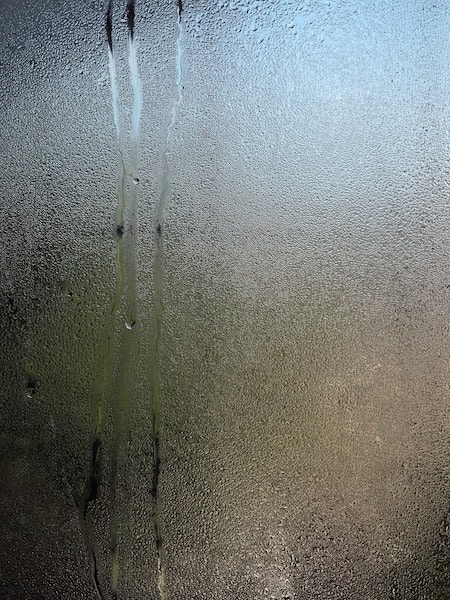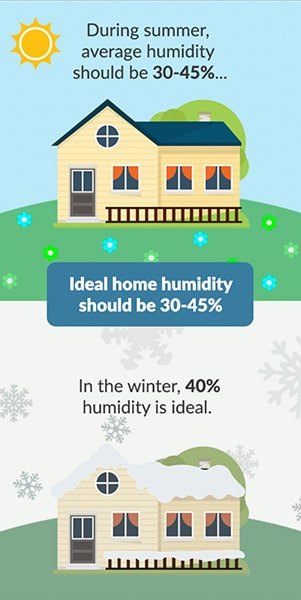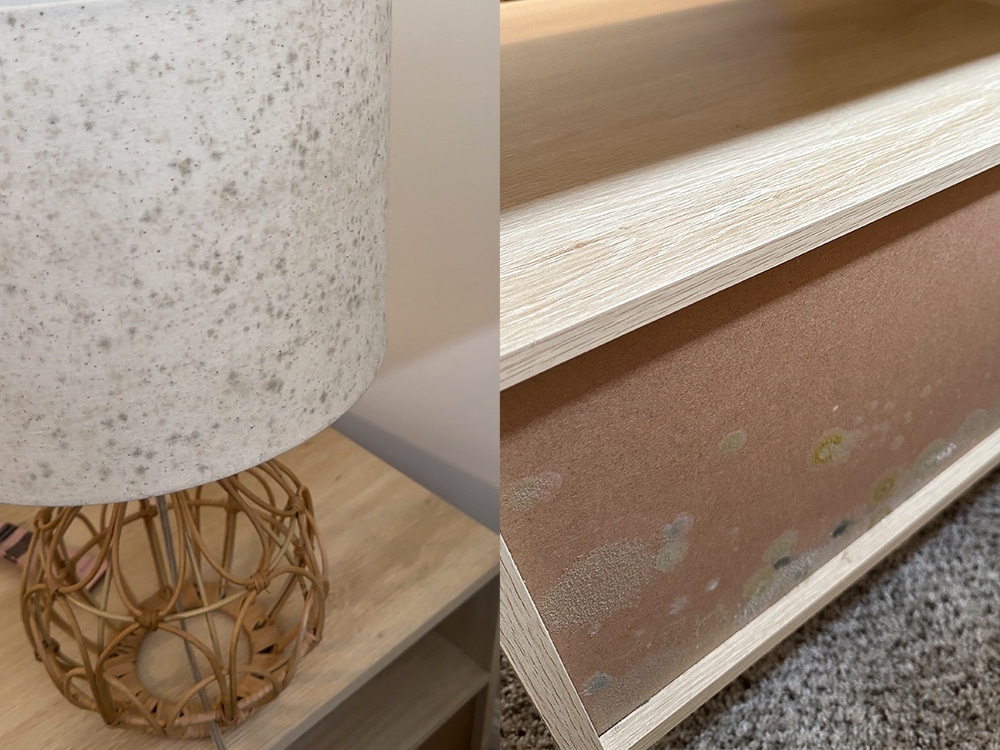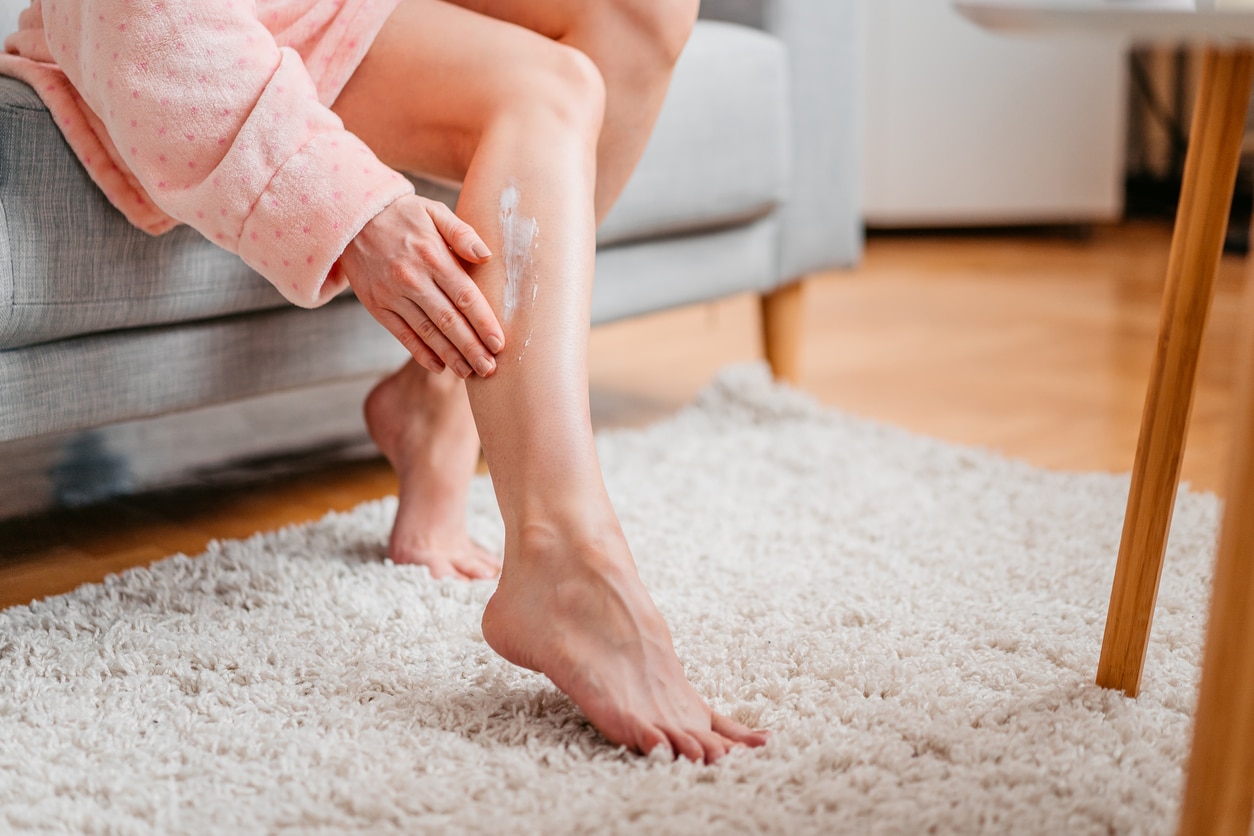
What Is Humidity?
We often think of humidity as that heavy, wet, sticky feeling in the air when outdoor temperatures rise. What we don’t often consider is that humidity can also mean the lack of moisture in the air outside and inside. You know it when you feel it.
Whether we are trying unsuccessfully to get comfortable and sleep with the AC on high and a fan pointed straight at us in the summer, or we are inside wrapped in blankets with dry skin and chapped lips during the winter, humidity plays a large factor in both comfort and health.
Absolute vs Relative Humidity
There are two kinds of humidity: absolute and relative.
- Absolute Humidity (g/m³) = the water mass in the air divided by the air mass in a room. In other words, it tells you the amount of water in the air.
- Relative Humidity = the amount of water in the air vs. how much water it could hold. This is the term you are likely more familiar with and the one you will use to gauge your home’s humidity level.

Humidity and Your Home
This probably has you asking, “What should humidity be in the house in winter, summer and throughout the year? During the colder, winter months staying below 40% humidity is ideal, while in hot, summer months the average humidity should be between 30-45% (or below 50%, depending on your preferences).
Measuring Humidity Levels
One way to make sure your home is staying within the ideal humidity range is to invest in a hygrometer. This device measures the amount of moisture in the air. It is inexpensive and available at your local hardware store or, no doubt, plenty of places online.
A hygrometer can also come in handy as different areas of your home have various humidity levels (think: your basement, kitchen, and bathroom vs. bedrooms and living areas). For instance, areas like basements and crawl spaces tend to have higher moisture levels because they are susceptible to moisture and leaks from the ground below and around them.
Unfortunately, that also means they are susceptible to mold growth as these spaces have limited airflow and trap moisture. Having a home with too high or not high enough humidity levels can cause a number of problems for your property and your health.
What is High Humidity?
Anything over 50–60% could be considered high humidity, especially during certain seasons in certain regions. A sign that the humidity is (too) high in your home is moisture on the windows. This often happens during/after cooking, taking long, hot showers, and doing the dishes.

Common Consequences of High Humidity
- Foul Odors
- Mold, fungus, dust mites and rotting
- Rusted and corroded metal
- Ruined floorboards
- Weakened floor joists
- Condensation in your walls, which leads to structural damage and wood rot
- Pests such as termites, carpenter ants, wood-eating beetles, and others that love rotting, moldy wood
- Allergens and allergies
- Respiratory problems
- Sleep interruptions
- Feeling lethargic, irritable, and generally unwell
- Higher utility bills
How to Lower Humidity in House
Some helpful and even creative ways to reduce the humidity in your home include:
- Running AC or furnace (Note: an oversized AC or one that is continuously running could increase the humidity)
- Using your AC, exhaust, and ventilation fans (especially while showering and cooking)
- Trusting your mini-split thermostat to automatically monitor and maintain a certain level of humidity without your constant manual manipulation. However, when you do have to step in, most can be controlled by an app or other smart home devices
- Installing a Dehumidifier
- Whole House Dehumidifiers – These fit inside your furnace air handler and remove moisture from the air before it moves through your ductwork
- Portable/room dehumidifiers – Often a fit for basements
- Sealing crawl space vents
- Putting a plastic cover over crawl space dirt
- Installing crawl space vapor barrier on walls and floors
- Fixing leaky pipes (these only add moisture to the equation)
- Insulating cold-water pipes
- Cleaning gutters to avoid leaks inside, and directing downspouts 6 ft. away from the house
- Taking cooler showers
- Drying laundry on a clothesline outside (unless restricted by your neighborhood bylaws)
- Moving moisture-releasing plants to a well-ventilated room or outside
- Setting out a basket of charcoal briquettes (which are highly absorbent), then replace every 2-3 months
- Opening a window
- Adding storm doors, drapes, blinds, double / triple-paned windows, caulk, and weather strips to help insulate and separate your home from moist outdoor air
- Leaving inside doors open for better air circulation
- Using area rugs that can be taken up and washed often. In certain climates, if carpet is to be installed over a concrete floor, it may be necessary to use a vapor barrier (plastic sheeting) over the concrete and cover that with sub-flooring (insulation covered with plywood) to prevent a moisture problem.” (will add foonote: EPA)
- Vacuuming and changing HVAC filter(s) routinely
What is Considered Low Humidity?
If the ideal range for relative humidity is 30–50%, anything below 30% is considered low, and comes with its own list of disadvantages to your home and health.

Without enough humidity in the air, you will notice a spike in:
- Wood floors and furniture drying, cracking, shrinking/warping
- Millwork and paint drying and cracking
- Static electricity
- Damaged electronics and musical instruments
- Allergies
- Asthma
- Dry skin and hair
- Chapped lips
- Cough, wheezing, and other breathing problems
- Interrupted sleep
- Increased susceptibility to colds and respiratory illness (viruses and germs thrive in this kind of environment)
How to Increase Humidity
What do you do when you need to know how to increase humidity in a room? First, it is helpful to know that the benefits of increasing the humidity levels are not insignificant. On top of relieving the above-listed symptoms of low humidity, snore relief is also a perk of more balanced air quality. This is huge for the person snoring getting better quality sleep and for partners trying to escape the freight train noises coming from the next pillow!
Some useful and creative ways to increase the humidity (and your comfort) include:
- Installing a Humidifier – Modern models automatically sense and maintain humidity at around 45% as well as prevent bacterial growth.
- Whole house humidifiers are installed directly inside your furnace and help add moisture through your home’s ductwork with the help of a humidistat.
- Portable/room humidifiers come in warm and cool mist and are great for bedrooms and living areas.
- Opening the dishwasher after its last rinse cycle and letting the steam escape into the air rather than use the dry cycle.
- Simmering a pot of water on the stove
- Air-drying laundry inside – Your permanent press load is perfect for this.
- Letting hot bath or dishwater cool before releasing the plug
- Using a fine-mist spray bottle to spritz the air every hour or so
FAQ’s About Humidity Control
Relative Humidity is a measurement of the amount of water in the air vs. how much water it could hold. This is the number you use to gauge your home’s humidity level.
The top causes of humidity in the home are showering, boiling water, and drying clothes inside as well as ventilation and insulation issues. Using a whole house humidifier offers a great solution.
Some ways to remove moisture from your home include adding a:
- Dehumidifier to your home or “wettest” rooms
- Boston Fern or similar plant that removes moisture rather than adding it to the air
Yes. Humidity and poor indoor air quality may cause, contribute, or increase the likelihood that you will have infections, lung cancer, asthma, heatstroke, and heart problems. Too much humidity can make you feel lethargic, irritable, and generally unwell on top of making it hard to sleep and get good rest. Too little humidity can cause dry skin, chapped lips, cough, wheezing, other breathing problems, scratchy throats, nasal discomfort, and snoring.
Schedule A Service Online
If you are in the St Louis or Nashville area it’s easy and quick to schedule a service with Hoffmann Bros. Just use this online tool to get it done!
Speak With Someone
If you have questions, call us we’re in the office Monday-Friday 7am-7pm and on Saturday from 7am-5pm, we also have a team available 24/7 to answer your emergency calls.




